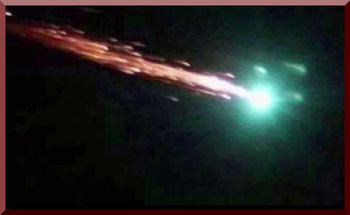Pilots See Big Green Fireball


U.S.A.F. pilot Captain William Goede, copilot Major Roger Carter, and Staff sergeant flight engineer, flying a C-47 from Lowry AFB, Denver, to Williams AFB, Chandler, AZ, at 18,000' saw a green fireball.
2nd green fireball sighting East of Sandia Mountains, 10 miles East of Albuquerque, at 9:27 p.m. shot up from the ground to 500' height.
At 9:27 p.m. on December 5, an Air Force C-47 transport was flying at 18,000' 10 miles East of Albuquerque.
The pilot was a Captain Goede.
Then the crew, Captain Goede, his co-pilot, and his engineer were startled by a green ball of fire flashing across the sky ahead of them.
It looked something like a huge meteor except that it was a bright green color and it didn't arch downward, as meteors usually do.
The green-colored ball of fire had started low, from near the eastern slopes of the Sandia Mountains, arched upward a little, then seemed to level out.
And it was too big for a meteor, at least it was larger than any meteor that anyone in the C-47 had ever seen before.
After a hasty discussion the crew decided that they'd better tell somebody about it, especially since they had seen an identical object 22 minutes before near Las Vegas, NM.
Captain Goede picked up his microphone and called the control tower at Kirtland AFB and reported what he and his crew had seen.
The tower relayed the message to the local intelligence people.
A few minutes later the captain of Pioneer Airlines Flight 63 called Kirtland Tower.
At 9:35 p.m. he had also seen a green ball of fire just East of Las Vegas, NM.
He was on his way to Albuquerque and would make a full report when he landed.
When he taxied his DC-3 up to the passenger ramp at Kirtland a few minutes later, several intelligence officers were waiting for him.
He reported that at 9:35 p.m. he was on a westerly heading, approaching Las Vegas from the East, when he and his co-pilot saw what they first thought was a shooting star.
It was ahead and a little above them.
But, the captain said, it took them only a split second to realize that whatever they saw was too low and had too flat a trajectory to be a meteor.
As they watched, the object seemed to approach their airplane head on, changing color from orange red to green.
As it became bigger and bigger, the captain said, he thought sure it was going to collide with them so he racked the DC-3 up in a tight turn.
As the green ball of fire got abreast of them it began to fall toward the ground, getting dimmer and dimmer until it disappeared.
Just before he swerved the DC-3, the fireball was as big, or bigger, than a full moon.
The intelligence officers asked a few more questions and went back to their office.
More reports, which had been phoned in from all over northern New Mexico, were waiting for them.
By morning a full fledged investigation was under way.
No matter what these green fireballs were, the military was getting a little edgy.
They might be common meteorites, psychologically enlarged flares, or true UFOs, but whatever they were, they were playing around in one of the most sensitive security areas in the United States.
Within 100 miles of Albuquerque were 2 installations that were the backbone of the atomic bomb program, Los Alamos and Sandia Base.
Scattered throughout the countryside were other installations vital to the defense of the U.S.:
Radar stations, fighter/interceptor bases, and the other mysterious areas that had been blocked off by high chain link fences.
Since the green fireballs bore some resemblance to meteors or meteorites, the Kirtland intelligence officers called in Dr. Lincoln La Paz.
Dr. La Paz said that he would be glad to help, so the officers explained the strange series of events to him.
True, he said, the description of the fireballs did sound as if they might be meteorites, except for a few points.
One way to be sure was to try to plot the flight path of the green fireballs the same way he had so successfully plotted the flight path of meteorites in the past.
From this flight path he could determine where they would have hit the Earth, if they were meteorites.
They would search this area, and if they found parts of a meteorite they would have the answer to the green fireball riddle.
The fireball activity on the night of December 5 was made to order for plotting flight paths.
The good reports of that night included carefully noted locations, the directions in which the green objects were seen, their heights above the horizon, and the times when they were observed.
So early the next morning Dr. La Paz and a crew of intelligence officers were scouring northern New Mexico.
They started out by talking to the people who had made reports but soon found out that dozens of other people had also seen the fireballs.
By closely checking the time of the observations, they determined that 8 separate fireballs had been seen.
One was evidently more spectacular and was seen by the most people.
Everyone in northern New Mexico had seen it going from West to East, so Dr. La Paz and his crew worked eastward across New Mexico to the West border of Texas, talking to dozens of people.
After many sleepless hours they finally plotted where it should have struck the Earth.
They searched the area but found nothing.
They went back over the area time and time again, nothing.
As Dr. La Paz later said, this was the first time that he seriously doubted the green fireballs were meteorites.
Within a few more days the fireballs were appearing almost nightly.